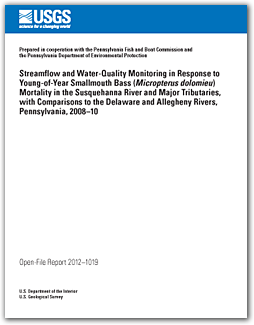 Abstract
Abstract
Since 2005, spring hatched young-of-year (YOY) smallmouth bass in Pennsylvania reaches of the Susquehanna River have experienced above-normal mortality when summertime streamflows are near or lower than normal. Stress factors include, but are not limited to, low dissolved oxygen and elevated water temperatures during times critical for survival and development (critical period is May 1 through July 31). At this time (2010), widespread disease and mortality are believed to be more prevalent for YOY smallmouth bass in the Susquehanna River Basin than in the Delaware or Allegheny River Basins.
The U.S. Geological Survey began a study in 2008 to investigate water temperature and dissolved oxygen as possible stressors to the YOY smallmouth bass. Monitoring began in 2008 and continued in 2009 and 2010 in selected reaches. Continuous (30-minute intervals) measurements of dissolved oxygen, water temperature, pH, and specific conductance were made during all or parts of the study at stations including, but not limited to, the Delaware River at Trenton, N.J. (station C1), Susquehanna River at Clemson Island (station C4), Juniata River at Newport, Pa. (station C5), Juniata River at Howe Township Park (station C6), Susquehanna River at Harrisburg, Pa. (station C8), and Allegheny River at Acmetonia, Pa. (station C10). At stations C1, C5, and C8, streamflow data also were collected. Streamflow data were not collected at stations C4, C6, and C10; therefore, data from nearby streamgages on the Susquehanna River at Sunbury, Pa. (station N8), the Juniata River at Newport, Pa (station C5), and the Allegheny River at Natrona, Pa. (station C9), were used to represent flow conditions at these stations.
Streamflow during the critical period of each year influenced dissolved-oxygen concentrations and water temperature, and was associated with the incidence of disease in YOY smallmouth bass. During the critical period of 2009, station C8 had a median daily streamflow of 26,300 cubic feet per second (ft3/s), approximately two times higher than for the critical periods in 2008 and 2010. Diseased YOY smallmouth bass were captured at only 3 sites in 2009 but 19 sites in 2008 and 28 sites in 2010.
During relatively low streamflow in the critical periods of 2008 and 2010, dissolved-oxygen concentrations also were lower (more stressful to aquatic life) than in 2009. During the critical period, median daily minimum dissolved-oxygen concentrations in main-channel habitat of the Susquehanna River at station C8 were lower in 2008 and 2010 by 1.2 milligrams per liter (mg/L) and 1.5 mg/L, respectively, in comparison to the median daily minimum concentrations in 2009. Despite the year-to-year differences in dissolved oxygen, results of a comparison of data for station C8 from each year of the study period with historical data from 1974–79 indicate daily minimum dissolved-oxygen concentrations in all 3 years of the study were significantly lower than those from the historical dataset (p-values less than 0.05). Although lower streamflows for critical periods of 2008–10 may help explain statistical differences in dissolved oxygen between the two time periods, other factors such as long-term streamwater warming trends also may play a role.
Median daily minimum dissolved-oxygen concentration in the microhabitat of the Susquehanna River at Clemson Island (station C4) was 1.6 mg/L lower in 2008 than 2009. No data were collected at station C4 in 2010. For the microhabitat of the Juniata River near Howe Township Park (station C6), median daily minimum dissolved-oxygen concentrations were about 0.6 mg/L lower in 2008 than in 2010. At station C6, no data were collected in 2009.
Nighttime concentrations of dissolved oxygen in microhabitats at stations C4 and C6 were at times lower than the 5.0-mg/L criterion established by the U.S. Environmental Protection Agency for early life stages of warm-water fish. The most frequent occurrence of dissolved oxygen less than 5.0 mg/L was at station C4 (31 of 92 days in the critical period of 2008). The longest duration that dissolved oxygen was lower than 5.0 mg/L was 8.5 hours (station C4; 23:30 on June 10, 2008, to 08:00 on June 11, 2008).
Median daily maximum water temperatures in the main channel of the Susquehanna River at station C8 were 4.0 degrees Celsius (°C) higher in 2008 and 4.3°C warmer in 2010 than in 2009 during the critical periods. At station C8, the water temperatures during the critical periods of all 3 years were significantly warmer (p-values <0.05) than during the critical periods of 1974–79. Year-to-year water-temperature differences in the main-channel habitat of the Juniata River at station C5 were slightly less than year-to-year differences in the Susquehanna River at station C8. During the critical periods, the water temperature at station C5 was 3.5°C warmer in 2008 and 3.3°C warmer in 2010 than in 2009. These results are consistent with warming trends documented in other streams of the northeastern United States with much more robust water-temperature datasets.
For the critical period of each year, dissolved oxygen in the Susquehanna River at station C8 typically was 1.5 to 3.0 mg/L lower than in the Delaware River at station C1 and the Allegheny River at station C10. Median daily maximum water temperatures during the critical period of each year ranged from 1.6 to 2.7°C warmer at station C8 than at stations C1 and C10.